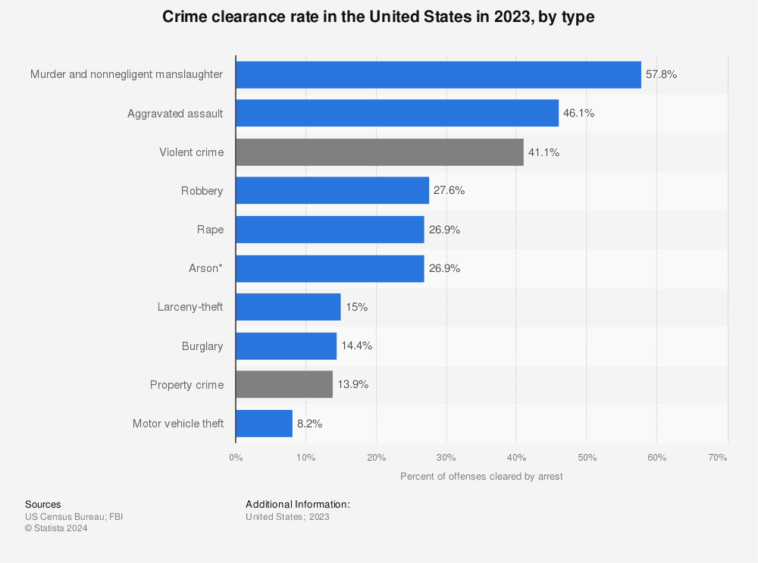In the aftermath of widespread calls for police reform in the United States, data released by the Federal Bureau of Investigation (FBI) revealed that by 2023, just over half—approximately 58%—of all recorded murders and nonnegligent manslaughters were resolved by law enforcement agencies. This metric, known as the ‘clearance rate’, is calculated by dividing the sum of arrests or exceptional clearances for a specific crime in a given year (like 2023) by the total instances of that crime reported to authorities within the same period.
A case is deemed ‘cleared’ if an arrest has been made or if the inquiry has reached a conclusion via exceptional measures. The law enforcement sector uses the phrase ‘exceptional means’ when an identified suspect is exonerated from charges due to circumstances beyond the control of the police. This could happen if, for example, the suspect meets an untimely death.
International statistics offer a stark contrast to these figures. Countries like Australia, the United Kingdom, and Germany showcase murder clearance rates in the 70th, 80th, and 90th percentiles respectively. This indicates a more effective law enforcement mechanism in these nations when compared to the United States.
However, it is important to note that even with nearly half of the murderers in the U.S. avoiding immediate capture, the clearance rate for this crime is relatively high. This is particularly true when compared to clearances for other major crimes.
An analysis of the crime clearance rates points towards a persistent issue for certain types of crimes. Vehicle theft, for instance, had a clearance rate of merely 8% in 2023. This is significantly lower than that of violent crimes such as rape, robbery, and assault, which had clearance rates of 27%, 28%, and 46%, respectively.
These troubling low clearance rates emerged following a distressing increase in the number of African American fatalities in the U.S. Between the years 2010 and 2019, the average number of homicides involving white victims was recorded at 5,954 across the decade. This number is almost 16% lower than the 10-year average for homicides involving African American victims.
During the aforementioned period, an average of 6,927 African Americans were killed each year- a number that shockingly rose by 43% in 2020 compared to the preceding 10-year average. This surge in crime coincided with the social and political movements revolving around race and police reform that gained momentum in 2020.
Societal movements such as Black Lives Matter and the ‘defund the police’ campaigns are considered instrumental in driving the narrative towards police reform. These movements, however, were also seen as contributing factors to the rise in crime during that period.
Prominent figures within the Democratic party vocalized their support for the ‘defund the police’ movement following the death of George Floyd. The aim of this movement is to reconsider the current law enforcement system and strive towards a structure that respects all citizens.
Key to this restructuring is the reallocation of funds dedicated to the police, diverting these to community services that seek to address the root causes of crime. This transformative view of justice aims to establish a safer and more harmonious environment for all members of society.

